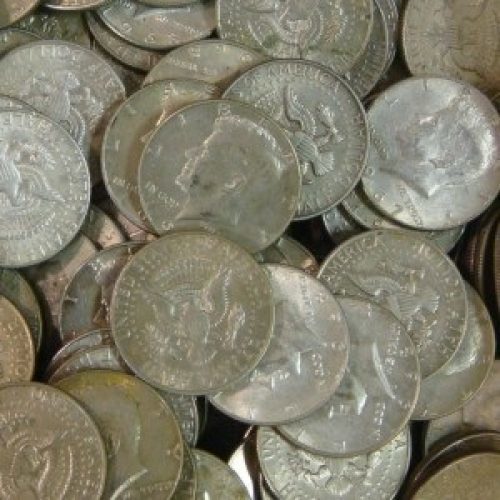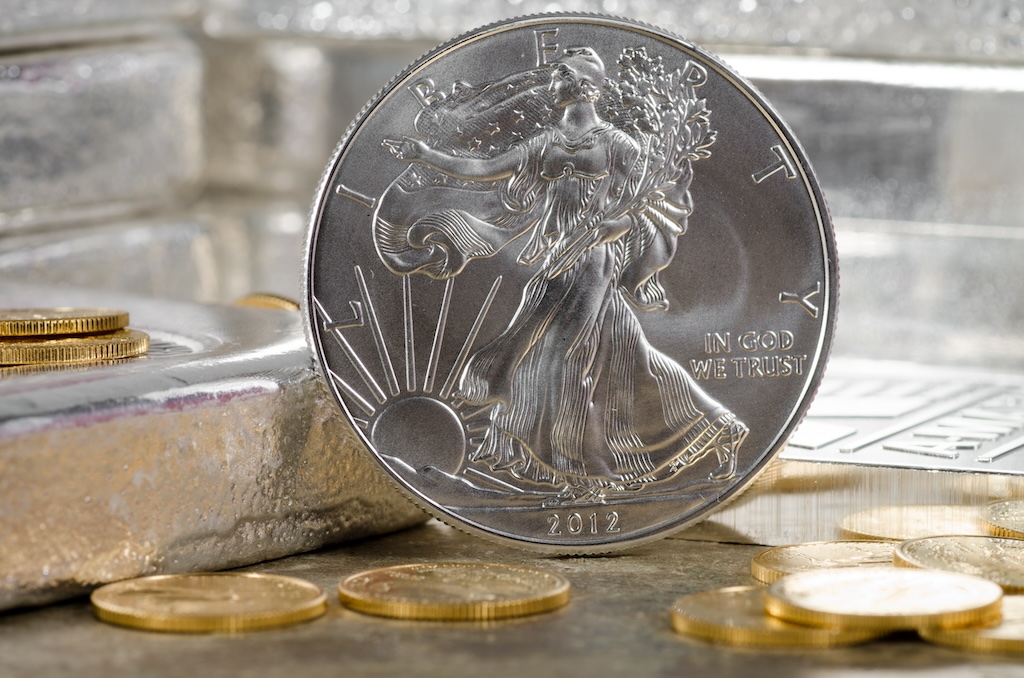As a pawn shop owner, I often come across two types of silver that spark interest: junk silver and bullion coins. Each type has unique benefits and can serve different purposes for collectors, investors, and those looking for a quick resale option. In this blog post, I’ll break down the key differences between junk silver and bullion, discuss their value, and offer guidance on when to buy one over the other.
What Is Junk Silver?
Junk silver refers to circulating coins that contain silver but have little to no numismatic value (collector’s premium). In the U.S., the most common junk silver coins are those minted before 1965—such as dimes, quarters, and half dollars—which are made of 90% silver.

Examples of junk silver include:
- Mercury Dimes (1916-1945)
- Washington Quarters (pre-1965)
- Walking Liberty Half Dollars (1916-1947)
- 1964 Kennedy Half Dollars
Junk silver is often sold in face-value bags (e.g., $100 worth of dimes and quarters) based on the coins’ silver content, not their face value.
What Are Bullion Coins?
Bullion coins are coins specifically minted for investment purposes, made with high-purity silver—usually .999 or higher. Governments or private mints produce these coins, and their value comes from the silver content and spot price.

Common bullion coins include:
- American Silver Eagles (.999 fine silver)
- Canadian Maple Leafs (.9999 fine silver)
- Austrian Philharmonics (.999 fine silver)
Bullion coins often carry a premium over the spot price due to their purity, recognizability, and liquidity in the investment market.
Key Differences Between Junk Silver and Bullion Coins
Premiums
Junk silver typically carries lower premiums over the spot price because it is valued mainly for its melt value. These coins, often from pre-1965 U.S. currency, are not produced for collectors or investors, which helps keep their premiums low. Their worth is closely tied to the amount of silver they contain, making them an attractive option for those looking to acquire silver without paying significant markups.
On the other hand, bullion coins tend to come with higher premiums due to their high purity and strong demand from investors. Coins like American Silver Eagles or Canadian Maple Leafs are specifically minted to appeal to investors, often featuring government guarantees of weight and purity. As a result, these coins are viewed as a reliable, standardized investment, which drives up both their desirability and the premium over the spot price of silver.
Liquidity
Junk silver is exceptionally liquid, particularly in small quantities. Coins like pre-1965 U.S. dimes, quarters, and half dollars are widely recognized and easy to identify, making them convenient for everyday transactions or bartering. Their smaller denominations provide flexibility, allowing them to be easily exchanged for minor purchases or broken down into smaller trades, which makes them popular among those preparing for emergencies or looking to hedge against inflation.
Similarly, bullion coins are also highly liquid, but their resale is generally limited to coin dealers, bullion traders, and investors. Coins such as American Silver Eagles or Canadian Maple Leafs are well-known and trusted within investment circles, making them easy to sell in the broader precious metals market. However, because bullion coins are typically issued in standardized weights (like one ounce), they are more suitable for larger transactions than for small-scale bartering or casual exchanges.
Intrinsic Value
Junk silver is known for being highly liquid, especially in small quantities. Coins like pre-1965 dimes, quarters, and half dollars are easily recognizable by the public, making them practical for everyday transactions or barter. Their smaller denominations allow for flexible trades, and they are often used as a hedge against inflation or for emergency exchanges, giving them widespread acceptance among collectors, investors, and everyday people alike.
Similarly, bullion coins are highly liquid, but their liquidity is generally limited to coin dealers, bullion traders, and investors. While coins like American Silver Eagles and Canadian Maple Leafs are widely recognized for their purity and value, they are typically sold in larger units and traded within specialized markets. This makes them an excellent choice for those looking to liquidate larger sums of silver quickly, although they are less convenient for small or informal transactions.
Numismatic Value
Although most junk silver coins are valued primarily for their silver content, certain coins with rare dates or key mintages can carry additional numismatic premiums. For example, some coins like low-mintage Walking Liberty Half Dollars or specific Mercury Dime varieties are sought after by collectors. These coins offer a unique opportunity for investors to benefit not only from their silver value but also from their historical significance or rarity, adding an extra layer of value.
In contrast, bullion coins are generally minted for their intrinsic silver content and investment appeal, meaning they typically have no numismatic value. However, there are exceptions for limited editions, proof coins, or special releases, which may attract collectors and accumulate additional premiums beyond their silver content. These specialized bullion pieces often come with unique designs, packaging, or limited mintages, giving them extra collectible value alongside their role as an investment asset.
When to Buy Junk Silver vs. Bullion Coins
When to Buy Junk Silver
Bartering and Small Transactions
Junk silver is ideal for those seeking small, divisible units of silver that can be used for bartering or emergency trades. Coins like pre-1965 dimes and quarters are easy to exchange for everyday transactions, making them practical in scenarios where smaller denominations of silver are needed. Their recognizability and utility in fractional trades make them a preferred choice for people preparing for economic uncertainties or looking for tangible assets that can be quickly traded.
Lower Premiums
For investors aiming to accumulate silver with minimal premiums, junk silver often presents a cost-effective option. Since these coins are valued primarily for their silver content, the premiums are typically lower than those of bullion coins. This becomes especially beneficial during times when bullion premiums spike, offering a more affordable way to build a silver portfolio without paying extra for purity or collectibility.
Coin Roll Hunting and Collecting
Junk silver also appeals to those who enjoy the thrill of coin roll hunting and collecting. While most junk silver is valued for its melt content, there is always the possibility of discovering rare dates or coins with numismatic value hidden within rolls or bags. This element of chance adds excitement for collectors who appreciate the historical and collectible aspects of these coins, making junk silver both a hobby and an investment opportunity.
When to Buy Bullion Coins:
Investment Purposes:
For those looking to invest in silver as a hedge against inflation or market volatility, bullion coins with higher purity are often the preferred choice. Coins like the American Silver Eagle or Canadian Maple Leaf are specifically minted for investment purposes, offering a reliable store of value. Their intrinsic link to the silver market makes them attractive during times of economic uncertainty, allowing investors to protect their wealth with a tangible asset.
Easy Resale to Dealers:
One of the key advantages of bullion coins is their easy resale to dealers and investors. Coins such as American Silver Eagles are widely recognized and trusted in the precious metals market, ensuring they can be quickly liquidated at fair market prices. This reputation among dealers makes bullion coins a convenient option for those who may need to convert their investment into cash without hassle.
Purity and Standardized Weight:
Investors who prioritize high-purity silver gravitate toward bullion coins, as these coins typically feature .999 or .9999 fine silver. Their standardized weights, such as one-ounce or larger bars, make them easy to sell internationally and align closely with the current spot price of silver. This consistency ensures that bullion coins retain their value and appeal in global markets, making them an excellent choice for those focused on both investment precision and liquidity.
Comparing Junk Silver vs. Bullion Coins
| Feature | Junk Silver Coins | Bullion Coins (Silver Eagles, Maple Leafs) |
|---|---|---|
| Purity | 90% (U.S. coins) | .999 or .9999 fine silver |
| Premiums | Lower, closer to spot | Higher, due to purity and demand |
| Liquidity | High, especially for small transactions | High, mainly among dealers and investors |
| Intrinsic Value | Based on 90% silver content | Based on pure silver content |
| Numismatic Value | Occasionally, for rare dates and conditions | Limited to special editions or proofs |
| Ideal Use | Bartering, small trades, long-term hedge | Investment, bulk silver storage, resale |
| Examples | Pre-1965 dimes, quarters, half dollars | Silver Eagles, Maple Leafs, Philharmonics |
| Storage | Bulkier, as it comes in smaller units | More compact for larger amounts of silver |
| Best Buyer | Collectors, barterers, small investors | Investors, collectors, international buyers |
Which Should You Choose?
Whether to buy junk silver or bullion coins depends on your goals.
- If you’re looking for small, divisible pieces of silver that are easy to trade and offer lower premiums, junk silver is your best bet. It’s also great for those who enjoy the thrill of coin hunting and finding rare dates.
- If you’re an investor focused on purity, brand recognition, and easy resale to dealers, bullion coins like Silver Eagles or Maple Leafs offer the advantage of high-purity silver with global demand.
For many buyers, the best strategy is to diversify by holding both junk silver and bullion coins. This way, you have smaller units for barter and emergency use, as well as larger, pure silver coins for long-term investment.
If you’re looking to buy or sell junk silver or bullion coins, stop by our shop—we’ll be happy to help you find the right silver for your needs!